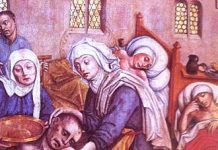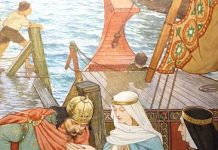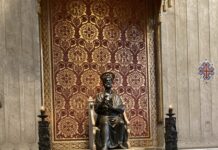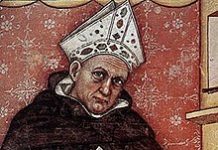I love art—particularly paintings. I love the way that paintings have their own language, where so much can be conveyed in a single image. Generally, I prefer classical works. I’m not big on modern works, and up until a few years ago, there were absolutely no modern artists in my favorites list. Then one day, quite by accident, I fell in love with Picasso.
It was all because of a single work, painted in 1896 when Picasso was a mere fourteen years old. I looked at this painting, “The First Communion,” and I had no choice but to reevaluate everything I knew about Picasso. Because for anyone to go from this
 to this (“Portrait of Dora Maar”):
to this (“Portrait of Dora Maar”):
 there had to be a reason. There had to be motive. Something massive had to affect the young artist. No one changes their style that dramatically without some fundamental change of ideals.
there had to be a reason. There had to be motive. Something massive had to affect the young artist. No one changes their style that dramatically without some fundamental change of ideals.
So I read a handful of biographies on Picasso and I finally found it—the thing that changed.
Any account of Pablo Picasso’s life tells us that around 1899 he returned to Barcelona after studying in Madrid. He left behind the classical techniques of his youth. He threw off the authority of his parents. And around the same time, he left the Church.
The fascinating thing about Picasso’s work is that in it one sees the arc of art in general. The rejection of the classics, the embracing of first the Avant-garde and then the meaningless is all there. And curiously enough, the thing that triggers the whole process is a rejection of God.
Art is inextricably connected to God. We humans are made in the image of a creator and it is in our nature to try to create things of our own. We can’t manage without art any more than we can manage without deities. We just can’t. The only alternative then is to break art down—to lower it to a level that anyone could reach. Picasso once said, “It took me four years to paint like Raphael, but a lifetime to paint like a child.” Why? Because if a master painter chose to paint like a child, then anyone could be a master painter. An elephant could be a master painter, and if an elephant can be a master painter, then humans are not anything special—just another species that evolved randomly from the primordial ooze. And as we learned years ago from The Incredibles, “When everyone’s special, no one is.”
Picasso’s works tell the story of what happens to art when artists reject God. They highlight the journey of art from the sublime to the ridiculous, from genius to insanity, from deeply connected to God to as secular as possible. It is a journey that is repeated in nearly every area of study from literature to science.
There is some speculation that Picasso strove to die in full communion with the Church. I sincerely hope that that is true. Whatever the case, he left the world an intriguing visual on a world without God.










